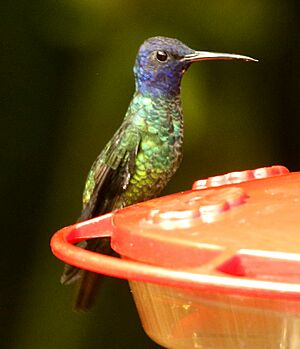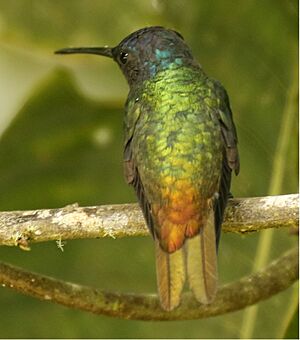Golden-tailed sapphire facts for kids
Quick facts for kids Golden-tailed sapphire |
|
|---|---|
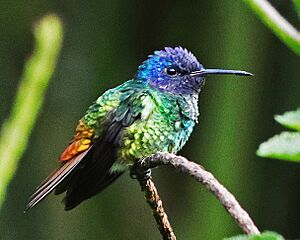 |
|
| Male in eastern Ecuador | |
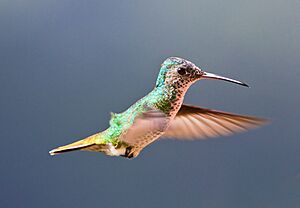 |
|
| Female C. o. oenone | |
| Conservation status | |
| Scientific classification | |
| Genus: |
Chrysuronia
|
| Species: |
oenone
|
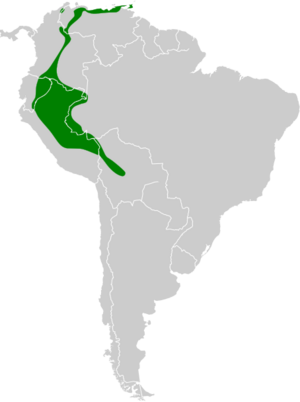 |
|
| Synonyms | |
|
Amazilia oenone |
|
The golden-tailed sapphire (Chrysuronia oenone) is a beautiful hummingbird known for its shiny feathers and golden tail. It belongs to the bird family Trochilidae. You can find this amazing bird in several countries in South America, including Bolivia, Brazil, Colombia, Ecuador, Peru, and Venezuela.
About the Golden-tailed Sapphire
How Scientists Classify This Bird
Scientists group living things to understand them better. The golden-tailed sapphire was once in a group called Amazilia. But after new studies, most scientists now place it in a different group called Chrysuronia.
There are also a few types, or subspecies, of golden-tailed sapphire. These are slightly different versions of the same bird. The main subspecies is C. o. oenone. Another one is C. o. josephinae. Some scientists also recognize a third, C. o. alleni.
What Does a Golden-tailed Sapphire Look Like?
The golden-tailed sapphire is about 9.5 to 10 centimeters (about 4 inches) long. Males usually weigh a bit more than females. Both male and female birds have a slightly curved bill. The top part of their bill is black, and the bottom part is red with a black tip.
Male Golden-tailed Sapphires
Adult males of the main subspecies have a bright violet-blue head and throat. Their back is a shiny green, which changes to bronze-green. Their tail feathers are a bright coppery-bronze color, giving them their name. Their chest is a glittering green, and their belly is bronze-green.
Female Golden-tailed Sapphires
Adult females have a blue crown on their head and a green back. Their tail feathers are also copper-bronze. Their undersides are mostly whitish. They have blue-green spots on their throat and neck, green on their sides and chest, and bronze-green on their flanks.
Young Golden-tailed Sapphires
Young males have a dull green head and a dusky gray throat. Young females have duller, more bronze-colored spots on their throat than adult females.
Where Do Golden-tailed Sapphires Live?
The main subspecies, C. o. oenone, lives in many places. You can find it along the border of Colombia and Venezuela. It also lives in western and northern Venezuela, and south through eastern Colombia, eastern Ecuador, and a small part of western Brazil. It even reaches into northeastern Peru.
The C. o. josephinae subspecies lives in most of the rest of eastern Peru. The C. o. alleni subspecies is found in northern Bolivia.
Their Favorite Places to Live
Golden-tailed sapphires like semi-open areas. They live at the edges of humid forests and in gaps within the forest. They also enjoy older secondary forest (forest that has regrown after being cut down) and gallery forest (forest along rivers). You might even spot them in shady cacao and coffee farms, and in gardens.
In Colombia and Venezuela, they live from sea level up to about 1,500 meters (about 4,900 feet) high. In Ecuador, they are found between 400 and 1,200 meters (about 1,300 to 3,900 feet) high.
Golden-tailed Sapphire Behavior
Movement
Golden-tailed sapphires seem to move around locally. They do this to find flowering plants when they are in bloom. However, scientists don't have all the details about their exact movements.
Feeding Habits
The golden-tailed sapphire drinks nectar from many different flowering shrubs and trees. Some of their favorite plants include Aphelandra, Erythrina, and Inga.
Male hummingbirds often look for nectar high up in the tree canopy. They sometimes gather in groups, which can be a bit noisy as they argue over food. Females tend to fly along a regular path, visiting a circuit of flowering plants in the forest. Besides nectar, they also eat small insects and spiders. They catch insects by flying out from a perch or by picking them off leaves.
Reproduction and Life Cycle
The breeding season for the golden-tailed sapphire changes depending on where they live. In eastern Colombia, they breed from June to November. In western Brazil, it's from January to April.
Males often gather in groups of five to 10 birds at special display areas called leks. Here, they show off to attract females. Sometimes, a male will display alone.
The nest is shaped like a cup and is covered with green moss on the outside. This helps to camouflage the nest, making it hard to see. The female lays two eggs. She sits on the eggs for about 14 days to keep them warm. The young birds leave the nest about 28 days after they hatch.
Vocalizations
The song of the golden-tailed sapphire can vary. It's often described as a repeated, rhythmic phrase. It might start with a rough note, followed by several very squeaky or scratchy notes, and then end with repeated chipping sounds. They also make calls that sound like a long, metallic trill and shorter chipping notes.
Conservation Status
The IUCN (International Union for Conservation of Nature) has listed the golden-tailed sapphire as a species of Least Concern. This means that it is not currently at risk of disappearing.
This hummingbird lives in a very large area. Even though scientists don't know the exact number of birds, they believe the population is stable. There are no immediate threats that have been identified for this species. It is considered common in Colombia and Venezuela, but it is a bit rarer in the Amazon lowlands further south.



